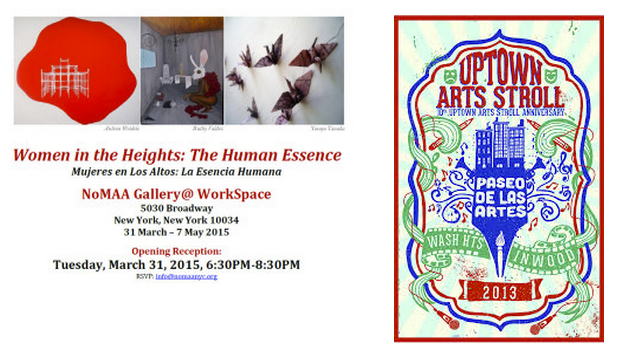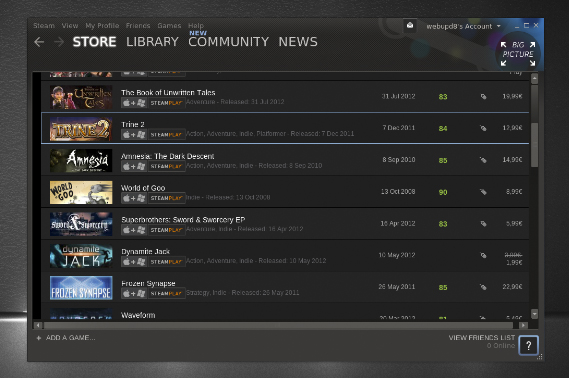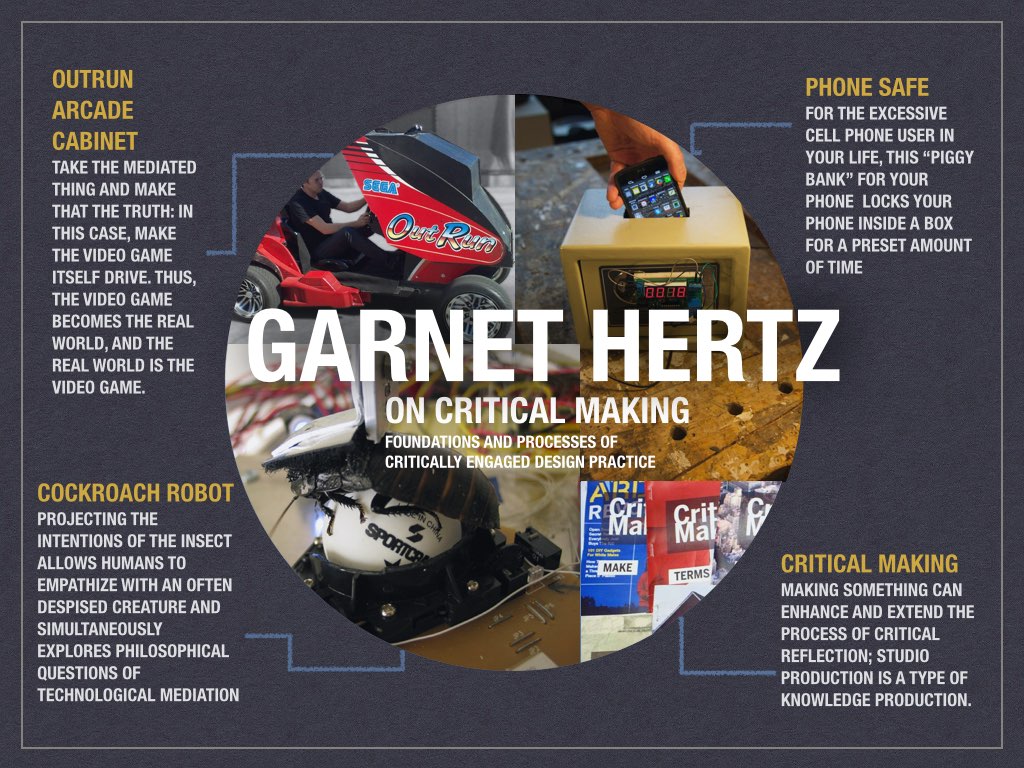
Garnet Hertz on Critical Making:
Foundations and Processes of Critically Engaged Design Practice
Nitesh Singh, Mariana Corona, Joanna Aliano Ruiz
“No cockroaches were hurt during the making of this project,” Garnet Hertz reassured the audience after introducing his exhibition project Cockroach Controlled Mobile Robot. “Well, the only time I’ve actually had them die was when I fed them lettuce that was leftover from a hamburger…and it’s because it’s filled with pesticides. I didn’t think about that,” Hertz, Canada Research Chair in Design and Media Arts and Associate Professor in the Faculty of Design and Dynamic Media at Emily Carr University, quipped. “But that’s another lecture.”
Ben Vershbow and Dragan Espenschied: Archives, Artifacts and Digital Culture
Group Members: Michelle Wainwright, Melinda Jeune, Annette Slaughter and Ethan Arnowitz
“The future is already here, it’s just not evenly distributed” – William Gibson
New York City has inhabited the island of Manhattan for nearly 400 years. The New School University Center just celebrated its first birthday. Have you ever stopped to think about what used to exist where The New School stands now? What about your East Village apartment, or even the Deli around the corner?
While it can be easy to get caught up in the fast-paced, subway-commuter lifestyle of Manhattan, it is important to appreciate New York as a city built upon many layers of history, and to realize that these historic details of our city’s past are crucial in developing its future.
It is this “layer cake of history” that Ben Vershbow, the director of New York Public Library Labs, and his team devote themselves to — and to discovering and reformatting that history in a way that is interactive, user-friendly and inspiring. NYPL Labs is reinventing the way we think of the public library and, through a variety of exciting projects, creating a framework others can use to build our community.
One area NYPL Labs is particularly fascinated by is their map collection and the development of digitally interactive tools to turn old maps of New York City into relevant information the public can use today.
For instance, contributors have used the “Map Warper” — developed in 2009 and getting a makeover later this year — not only to align myriad maps, but also to trace the outline of 150,000 building footprints on those historic maps. Those plotted buildings then become searchable entities. However, because this process is not fully automated and often requires a user to quality-check the data, it has proven to be a time-consuming “bottleneck” process. Thus, NYPL Labs has integrated creative crowd sourcing to aid in the work. “Building Inspector,” a related crowd-sourced mapping tool, aims to tap into the casual, spare time people spend on a daily basis surfing the web. It seems to have worked, as over one million classifications have already been produced.
Ben and his team are especially excited about a new project NYPL Labs has in the works titled “NYC Space/Time Directory.” After winning a grant from the Knight Foundation, Ben and his team are planning to build a service that uses historical data of old New York in a way that is relevant to the New York we know today — a kind of “Google Maps interface through time.”
Through this community-driven directory, one will be able to look up historical locations, events, and people in context and “eventually enable augmented reality-type experiences.” By reaching out to historians, other institutions and the tech community, NYPL Labs hopes to build a framework others can work off of, essentially allowing historical information from maps, letters, pictures and more to be searched the way we search things today.
The innovative projects underway in the NYPL Labs are part of a growing movement to bring our culture and history into the digital age. This movement has proven to be a great challenge — finding a way to present archived information in a way that is meaningful and accessible using technology. This is part of a larger enterprise known as “digital conservation,” which seeks to ensure that historical materials are digitized and conserved, and that born-digital materials will be retrievable in the future.
Dragan Espenschied, a self-proclaimed Digital Conservator and Media Artist, shares Ben’s sentiment that the internet can be used as a tool for preserving endangered information. As the internet has become integrated more and more into our daily lives, it has begun to drastically change the way we interpret information.
In 2011, Dragan helped develop a project called “Once Upon,” which displays the exponential evolution of internet browsers with each passing year. Internet browsers are perpetually being updated (ostensibly) to help us better filter and visually process the information we seek online. To further illustrate this evolution, he presented a tutorial of what it would be like to browse the internet in the present day using a Netscape browser from the 1990’s on an antiquated computer desktop. The browsing experience was less than ideal compared to what we expect from our current browsers; it was riddled with glitches and errors, and it loaded at a fraction of the speed we are used to today.
Another one of Dragan’s projects, one that truly blends his two titles of Digital Conservator and Media Artist, was his Facebook spin-off. The spoof of the heavily used social media site demonstrated how users would have interacted on Facebook if it were established decades earlier. The Facebook spin-off is an enlightening example of how current trends, events and technological capabilities affect the way we interact and the language we use on social media.
Today on Facebook, we establish the value of other users content by clicking a “Like” button. However, Dragan maintains that had the website been established before the boom of the digital age, we might likely use the term “Vote” to show our appreciation for a status or picture, as that was common language regarding internet participation. His project also demonstrated how different the format of a social media website would be, due to the drastic difference in internet browsers of the time.
The true beauty of the internet is that the amount of information that can be accessed by a single user is unimaginably expansive, especially due to the fact that anyone with an internet connection can potentially contribute their own information. Dragan demonstrated this potential using the idea of “Digital Obscurity,” which is the act of a user encountering content on the internet that has previously gone entirely undiscovered.
Dragan shared an example of Digital Obscurity by displaying a homemade computer game discovered by a friend on an archaic hard disk drive from the early 1990’s. This primitive game, titled “Bomb Iraq,” was little more than a digital flipbook, but nonetheless it was likely that it had previously only been seen by the original creator. This deeply intimate discovery is a prime example of how the internet can create connections that would have been impossible decades ago.
It is clear that the internet has been used largely to help connect us with the world outside of our communities, but it also helps us connect more deeply with the ones we live in. Through Ben’s projects in the NYPL Labs, he proves that physical archives can provide great meaning and serve as a force for cultural enlightenment when merged with digital tools on the internet. These projects, linking the past and the future, demonstrate one possible vision of our libraries’ place in an ever-evolving digital culture — one that is still situated within an ever-expanding digital and analog past.
Furthermore, digital conservation and the projects Dragan has undertaken are increasingly important as we take the internet into a new age of utilization. To study its development and ever-changing nature will be crucial in order to optimize the way we integrate the internet and other digital tools into our daily lives in our search for information — not to mention preserving the internet itself, as one of the key cultural productions of our time.
Lindsey Clark Anitra Lourie Zoe Middleton
Curating At The Crossroads
1. Why A Manifesto?
We’ve chosen the format of a manifesto to respond to Chi-Hui Yang’s talk for two key reasons. Curation and “high art” are often seen as inaccessible topics, and we hope that the energetic and mass-audience tone of a manifesto will help to make the subject matter more approachable. Secondly, our response to Yang’s lecture includes several re-imaginings of curatorial practice and provides loose guidelines for each. Since manifestos frequently carry both radical visions and concrete action steps, the format felt exceptionally appropriate.
2. Visual Elements
Interspersed through this work you will find graphic and visual elements meant to help convey some of our concepts. These visuals will hopefully allow for a richer understanding of our arguments and permit readers to interact with theoretical and experimental proposals on a more concrete level.
3. The Importance of Questioning
Before providing any speculative advice on how to curate, we must address the question of, well, questioning. Questioning and knowledge seeking is the bedrock of knowledge production (and a good curator is a knowledge creator par excellence).
Below we’ve provided a visual that poses some important questions to consider when approaching curation.
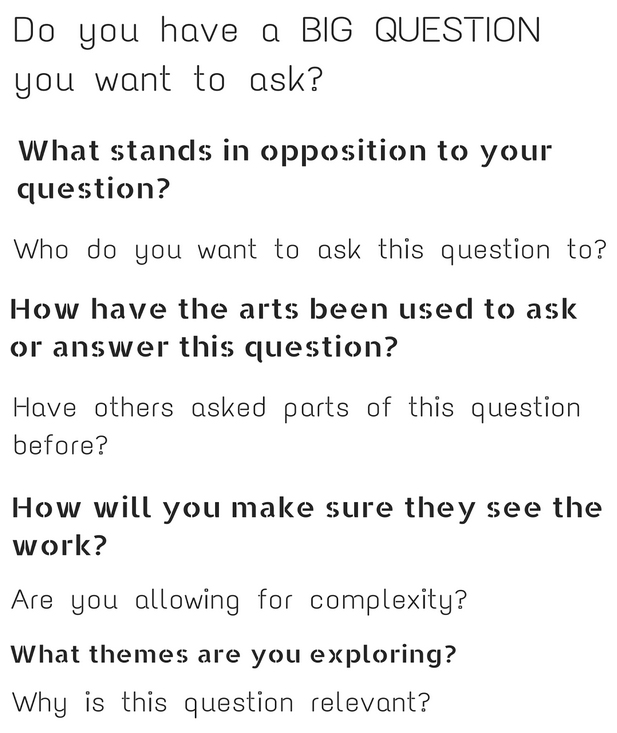
Types Of Curating
Categorized Curating
Chi-hui Yang challenges some of the standard forms of curation that often categorize artwork. He explains that these “safe” forms of curation do not always generate new perspectives and methods of engagement. The ever-popular retrospective format that focuses on one artist, time period, or location, can offer a somewhat limited view of the inspirations, conflicts, and influences of the work. The upcoming retrospective of Taiwanese artist Tsai Ming-liang at The Museum of the Moving Picture is an example of this style of curation. While certainly providing an effective introduction to the filmmaker, the choice to categorize the artist’s work as strictly Taiwanese is problematic. Ming-liang’s work, Yang points out, is frequently cosmopolitan, often French-financed and made for European audiences. Interacting on a broader, if more ambiguous, level with the work could yield much more compelling conversations and benefit the audience.
Radical Juxtaposition
Radical juxtaposition is a curatorial strategy that invites complexity instead of balking at it. The goal is to present a challenging combination of works that can produce new questions and perspectives in communal contexts.
Yang admits that this strategy can be hard to swallow for some audiences, but maintains that adventurousness, like curiosity, is a crucial part of creating new knowledge. Consider, for example, the recent combination of Stanley Nelson’s film “The Black Panthers: Vanguard of the Revolution” and Kevin Jerome Everson’s “ Park Lanes” in The Museum of Modern Art’s Documentary Fortnight. The two films have completely different narratives, styles, settings, and distribution, yet their pairing might bring the viewers to make new and unique connections. These reflections offer an alternative way for the viewers to engage in the public conversation about race, labor and social movements.
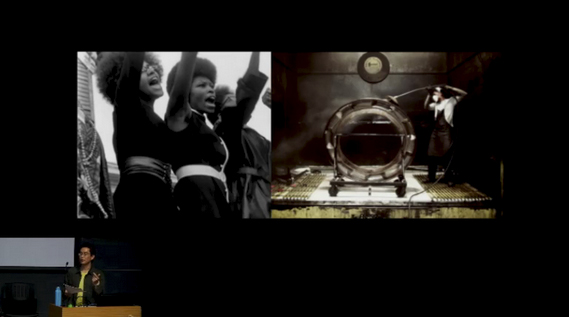
What follows are speculative forms of curation that we’ve developed in response to Yang’s lecture. These are by no means edicts for curatorial practice, but rather experimental guidelines. These probes are meant to help viewers grapple with the complexity of some subjects and to reduce the distance between art and audience.
The Complicated Biography
The Complicated Biography is a riff on the more sanitized retrospective. In this strategy a curated show must deal with the complex or problematic elements in the artist’s past, process, or common interpretations of the artist’s work.
For example, new medical speculations as to the physical and mental state of Vincent Van Gogh (as well as the standards of treatment at the time) could help to frame his work just as interestingly as the personal letters that are frequently used to provide context for his paintings. Similarly, Paul Gauguin’s work could be presented as an example of the male gaze, part of Orientalist narratives of the South Pacific, or presented in (radical) juxtaposition to the Japanese photographer Kohei Yoshiyuki’s voyeuristic, appropriative series that captured public displays of sensuality in Tokyo’s parks almost a century after Gauguin’s death.
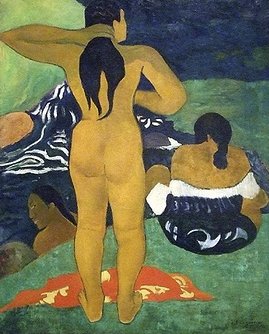
Gaugin’s Bathing
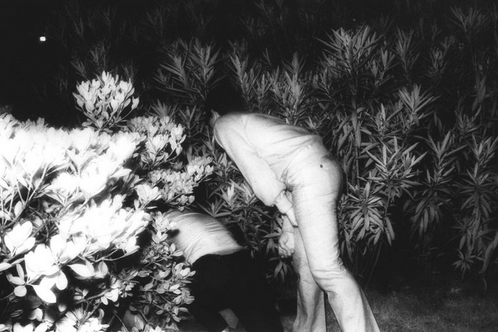
Kohei Yoshiyuki’s The Park Series
Community-oriented Curating
We’ve created the term community-oriented curating to reference curatorial strategies that not only ask difficult questions, but also design their shows with the needs of various communities (especially otherwise disenfranchised groups) in mind. Those needs should be reflected in a variety of ways — from from the themes chosen to the accessibility of the exhibition space. If one imagines a spectrum with art at one end and audience the other, there are numerous social, environmental, and cultural barriers that prevent audiences from experiencing a show. Some of these barriers are illustrated in the diagram below. A community-oriented curator must consider such concerns in mounting and promoting their show.
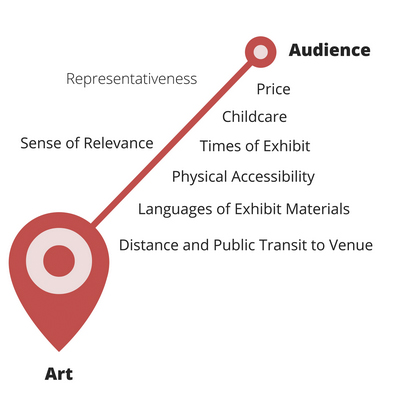
Embedded Curating
Embedded curating is a term we’ve developed to discuss exhibitions that are community-oriented in their approach, but also located within the physical communities where the art was created or those where the themes of the show are especially salient. An embedded show is deeply reflexive to social issues and interests of the local population.
The Northern Manhattan Arts Alliance is a gallery-education space that caters to the communities of Washington Heights and Inwood. Their current exhibit, Women in the Heights: The Human Essence, “featur[es] works by women artists of Northern Manhattan, tackling issues affecting humanity”. Although their practice closely mirrors what we’ve described above as “embedded curating” the hours of the space are prohibitive for some community members.
Mobile-adapted Curating (The Tech Solutionist Approach)
So many present-day interactions with art and film happen outside of galleries, cinemas, and museum spaces. While experiencing works in those contexts is certainly valuable, it is also extremely formal. Mobile-adapted curating allows visitors the chance to engage with art in more intimate, comfortable settings by creating content that can be consumed on tablets, smartphones and the like. This style of curating, which is already being explored through various art blogs, websites, and online magazines, offers a flexible and contemporary platform for creative expression. Additionally, in an increasingly mobile world, this method once again increases accessibility and allows the audience to pause and return to works for multiple viewings and reference work from any location.
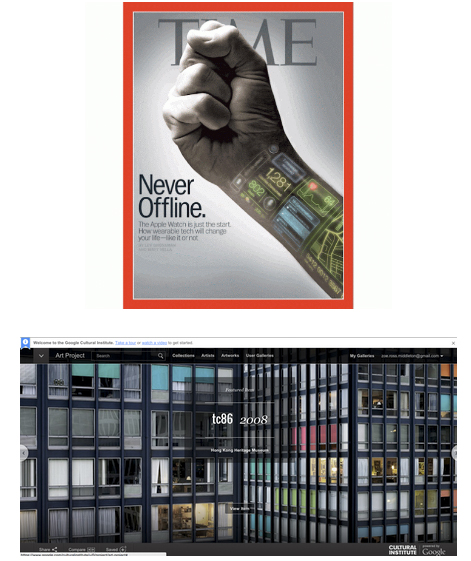
Small-Scale Curating
Small-scale curating is exactly what it sounds like. Instead of mounting large shows, an ambitious small-scale curator would select a handful of works to be shown to a smaller audience in a meditative space. This approach allows for curators to ask very concise questions of a work and for visitors to “lose themselves” in a piece more easily than they would in a crowded museum hall. Small-scale curating acts in opposition to the multi-tasking impulses of the day and brings the intimacy of mobile-adapted curating to traditional art spaces.

(Left) The Louvre gallery that houses Mona Lisa is notoriously crowded.(Right) Houston’s Rothko Chapel is a permanent display from a private collection, but an excellent demonstration of creating a contemplative space for audiences.
Conclusion
With the increased variety of mediums and settings within the profession, curation is at a crossroads. Contemporary curators have the opportunity to address major social issues across diverse platforms and for an equally diverse audience. Curators such as Chi-hui Yang endeavour to challenge the existing patterns of art viewing and utilise his projects for social discussion and exploration. We challenge the contemporary curator to step outside the box and consider some alternative methods of art organizing. Acknowledging the diverse factors that inform art making and prioritizing viewer experience can help stimulate conversations on specific timely and critical topics and promote the civic engagement needed for a radical form of change.
Ashley Cartagena Meghan Dunn Corey Paul
Intro
In her talk “Welcome to Flatland,” Professor Stephanie Boluk recounted 17 seconds that changed both the concept of the video game and the actual gaming practice of the software mega corporation, Valve. From her dynamic play-by-play of the pro-gaming world, we can see that rivalries between nations are strong; narrative and power dynamics are still changing; the importance and influence of playing the game as a hobby and the developing metanarrative of The Game are still emerging. What we’re left wondering is not what happens to Dark Seer after The Black Swan Spectacle, but what happens to the gamer who brought him to life?
By situating those 17 seconds within the context of the gaming enterprise and, subsequently, within the “flat” or “bossless” power structure of its primary arbiter, Valve Corporation, Boluk proved that the game is not an unassuming hobby for children. Over the past twenty years, Valve has evolved from a game developer (credits include Half-Life, Dota, Portal and Left 4 Dead) to the premiere digital distribution company; it now reigns over the gaming community. As gamer and commentator Jeff Dunn said in an article on the history of Valve for GamesRadar+, “Gamers dislike many things and many people, but if there’s one company that they have universally come to revere, it’s Valve.”
In our exploration of “Welcome to Flatland” we discovered that Valve is about so much more than the game. It’s about national pride in the pro-sport area. It’s about the economic ramifications and the social impact of navigating previously uncharted territories and organizational structures. Prior to Boluk’s presentation, we never imagined a video game could have such an expansive reach or incite such diverse discussion.
Perhaps it’s not just a game, after all.
GAMING AS SPORT
Video games are similar to professional sports in their commodification and – particularly in the case of broadcast or streamed games – in their spectator culture, but most average non-gamers would contest the inclusion of gaming as sport. What is it that defines a sport? Is it the physicality? Is it the competitive nature? Maybe it’s the skill?
According to the Oxford English Dictionary, sport (n) is defined as “an activity involving physical exertion and skill in which an individual or team competes against another or others for entertainment.” While the physical element may not be as present in gaming as it is in traditional sports like baseball, basketball, and soccer, a certain degree of dexterity, hand eye coordination, and mental fitness is required for any competitive gamer.
While society debates whether or not to include pro-gaming on the list of what is or isn’t a ‘sport,’ there is a massive population of fans and players that follow and participate in the gaming community. Electronic Sports, or “eSports,” is one of the fastest growing industries in the United States, South Korea, and around the world. Since the late 1990s, domestic and international gamers have traveled to various pro-division events. Capitalizing on these exponential participation rates, Michael Sepso and Sundance DiGiovanni established Major League Gaming in 2002. In 2013, the League of Legends Season 3 World Championships viewership surpassed that of the BCS National Championship and Game 7 of the NBA Finals, and drew twice the audience of the World Series with a whopping 32 million viewers. Regardless of its inclusion in the traditional “sport” category, it’s obvious that gaming is popular, influential, and – as Boluk’s presentation made clear – a spectacle that demonstrates and reimagines our conception of media.
In the commoditized world of pro-gaming, where 17 seconds can make or break a career, one can earn a sizable paycheck as a gamer, but there’s little promise of career longevity or sustainability. We no longer live in a world where parents can say to their children, “There’s no money in playing video games. Go do your science homework!” Major corporate sponsorships and a rapidly growing audience have created a new breed of professional gamer who can see a successful future of million dollar take-homes in tournament prizes and endorsement deals.
Boluk outlined how pervasive gaming and play have become, particularly within the framework of the metagame (the game universe outside the game itself), and its subsequent impact as an economic entity — but what happens when the tide turns in reality and the gamer steps away from his computer?
Like traditional sports, the gamer’s playing career is often short-lived, and there are no established trajectories for life after retirement. While the industry is utilizing the talents of these young gamers, the system is failing to provide a contingency plan for their futures. In an article for CNBC, “Pro gamers story: Get big, burnout, retire young,” Tom DiChristopher stated that most gamers retire by the age of 30. Gamers who gain popularity and financial success find themselves working day and night to maintain their status. Like pro athletes, these young gamers accumulate wealth from tournaments and contracts. According to the Bleacher Report, Sports Illustrated estimated that 78 percent of NFL players and 60 percent of NBA players were facing bankruptcy and serious financial stress within two to five years of retirement. Without proper guidance, young people with wealth often spiral into patterns of destructive behavior. Boluk’s comments remind us that it would be wise for the gaming industry to take initiative and develop policies regarding social responsibility especially as it pertains to young people who populate the majority of their audience.
GAMING AS CULTURE
Over the past two decades, gaming – both as a hobby and as a profession – has given rise to its own world, complete with active online forums, well-attended conferences, and community superstars with massive fan followings. YouTube, for example, plays host to a vibrant subset of the gaming community. Popular personalities like PewDiePie post videos with entertaining play-by-play commentary and critical reviews of new games.
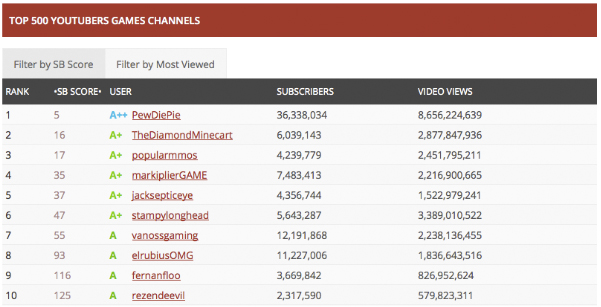
This table from SocialBlade reveals that the top 10 gaming channels have viewershipsranging from 2-36 million. According to Business Insider, gross annual income for top gamers isestimated to range between $500k-$8 million.
Gaming has found solid footing as its own cultural phenomenon, subverting the mainstream to create its own complex, hierarchical society in which gamers are divided and labeled by celebrity status, income, and international conference success. Though gaming as sport has important consequences for young and often vulnerable gamers, and while a handful of gamers (like those in the YouTube community) have claimed some autonomy as independent professionals, what is often overlooked is the impact of the game behind the screen.
In a world that’s so often taken solely for entertainment value, Valve and its CEO and co-founder, Gabe Newell, have experienced an unprecedented meteoric rise to the top. Boluk asserted Valve’s immeasurable reach as a sport, a spectacle, and a metagame on both domestic and international fronts. Yet, as previously mentioned, the questions surrounding ethics and exploitation within the sport are broad and urgent. What about the work environment in the so-called “flatland”?
According to Valve’s handbook, the company defies traditional corporate structure in order to foster an environment where their talented innovators will “flourish.” Valve is flat: “It’s our shorthand way of saying that we don’t have any management, and nobody “reports
to” anybody else. We do have a founder/president, but even he isn’t your manager. This company is yours to steer — toward opportunities and away from risks.” How is it that a company so firmly rooted in a culture of commoditization successfully implemented an anti-hierarchical operating structure? Is it possible that the flatland isn’t quite as flat as the two-dimensional space it occupies on our screen?
One of the most striking takeaways from our research on Valve and on Boluk’s presentation is the impressive community of makers that’s emerged from the proliferation of Half-Life, Dota, and Valve’s other wildly successful software initiatives. The action doesn’t stop when the gamer presses the power button and the screen goes black; the oil’s still burning at the Valve offices where employees have the “freedom” to decide their own projects and are encouraged to strive for productivity, assess their own success, and call the shots on their projects.
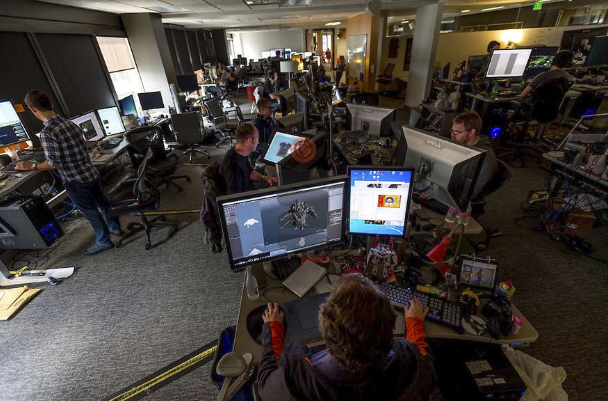
At the Valve offices, all of the desks are mobile and employees are encouraged to move frequently and with purpose. There are no bosses at Valve; everyone is on the same playing field. That flatland goes beyond the office; gamers have as much control over the company’s product as the company.
The notion of a flat company is so counterintuitive to traditional corporate sensibilities that it’s challenging to conceptualize the breadth of Valve’s progressive non-hierarchical management structures and even more difficult to imagine the impact the company has made on the individual employee and the gamer who willingly enters into the virtual social contract.
Sure, Valve’s unconventional practices create much debate fodder; Newell is equally frank about Valve’s aggressive hiring processes as he is about their aggressive firing tactics, as evidenced by the 2013 digital scandal whereby 25 employees were fired in one day, setting the internet forums and tech blogs buzzing. But the very existence of those conversations – the innumerable blog posts, the economic case studies, the transnational alliances that have formed as a direct result of Valve’s practices and products – evidence Valve’s significance not just as a corporation but as a culture maker. Valve isn’t just asking “would you like to play this game”; Valve is asking “would you like to reconsider your role in this community?”
In an increasingly digitized world where we’re so often screaming to be noticed in 140 characters or less, where the connections that link us are more often virtual than they are physical, it’s almost heartening to see such an influential entity looking to empower the individual by defining her own place, her own work, her own community within the corporate structure. However, Valve’s “flatness” in practice may be nothing more than a facade. Boluk pointed out that Valve’s approach to utilizing the skills of their software consumers to create content (as opposed to Valve creating the content themselves) was a successful method to subvert the pitfalls of an increasing piratized digital economy. Like the Valve employees who undoubtedly feel the pressures of increased productivity and the weight of a company’s fate on their shoulders, we wonder if the flatland is actually just a land of exploitation.
GAMING AS ECONOMY
“There is no fun, there’s no work. Whether gamer, employee or billionaire CEO, what remains is productivity,” Boluk said to end her presentation. Valve built its economic structure on the power of productivity, rather than the typical model based on production, believing a flat structure will increase productivity. This flat structure goes beyond the walls of Valve’s company headquarters in Bellevue, WA, and extends to every player that comes across these games.
Steam is an Internet-based digital distribution and management platform developed by Valve. In 2014, it was estimated that 90% of Steam’s content was user-generated. Valve isn’t making games; they are making the infrastructure for gamers to make their own games.
Valve is empowering users to create their own games or add to existing games. The question then becomes, is this play or is this work? Essentially, these players are volunteering their time and intellectual property to Valve, allowing Valve to make a profit from their contributions. Of course some players do make money off the items they create. In a recent Valve blog post, Valve announced that the “total payments made to individuals for the creation of in-game items sold in Team Fortress 2, Dota 2, and Counter-Strike: Global Offensive have passed $57 million. This money was earned by over 1,500 contributors spread out across 75 countries.” The company also acknowledged who they’ve been able to pay and how much they’ve been able to pay has been limited due to how quickly this model has grown. Many who’ve created for Steam have not been paid for their work.
Valve is not a publicly traded company, so they are not required to release financial data, but it’s been estimated that their net worth is in the billions. Newell says that the company, on a per-employee basis, is more profitable than tech giants like Google and Apple. Could this be the way of the future? Will other companies want to adopt this structure of valuing productivity using a flat structure? If so, what will this mean for the consumer, and how could this change our consumer economy? Has Valve blurred the line between work and play?
Valve’s unique approach to economic structure goes beyond the games. When Valve allowed players in Steam to cash out and move their currency from game to game, Valve started to see economic difficulties that a country might encounter. They saw inflation, deflation, and even recessions. This may seem like a virtual world with just “play money,” but think of the insight these games can give to economists. The economies inside these games could allow economists to experiment in ways they would not be able to do in real life. Valve even went so far as to hire Greek economist Yanis Varoufakis to oversee Steam’s economy. He’s now taken what he learned at Valve and is working as the Finance Minister of Greece. Only time will tell if studying the economies in these games will help economists, but it certainly opens a whole new and exciting world with endless potential.
IN CONCLUSION: GAMING AS SOCIETY
Judging just by the number of unanswered questions here, it’s clear that Valve’s practices – whether considered ethical or lacking social responsibility, progressive or exploitative, impressive or terrifying – are making an impact, inspiring important conversations about the definitions, the reach, and the possibilities of media in the 21st century. In the years to come, it will interesting to watch Valve and their “flat” organizational model evolve and, as Newell hopes, proliferate other economic sectors. This increased emphasis on productivity and employee autonomy brings a potential to affect numerous areas of society; from sports to child labor practices, piracy laws to digital copyrights, something as simple as a game could make a huge impact on economy and culture.
Entering into this presentation, we did not anticipate such a lively conversation over video games. Stephanie Boluk proved that, whether for better or for worse, Valve has ushered in a new era of the game in which what you see on your screen is no longer the whole picture. We learned that these are more than video games; there’s a complicated story and an army of employees, enthusiastic hobbyists, and professional gamers behind their creation. This world of the game is a complex one that carries incredible potential for social impact. When you talk about the game, you’re no longer talking about just a game or even a metagame. You’re talking about a society of makers. Welcome to Flatland.
Marc Fiaux Michele Baptist Gabriela Benazar Acosta
Description:
The following is an audiovisual response to artist Lawrence Abu Hamdan’s lecture from the Understanding Media Studies (UMS) course at The New School. The video is composed of footage taken from the aforementioned lecture; Lawrence Abu Hamdan’s April 24 keynote presentation in What Now? 2015: The Politics of Listening symposium, co-organized by the Vera List Center for Art & Politics and Art In General; and Brian Larkin’s Understanding Media Studies presentation, on March 9, about the use of loudspeakers in Nigeria. Bringing together Hamdan’s two talks into one creates a temporal bridge through space and time between the speaker and his audience. This juxtaposition of the repeated lecture brings to the foreground the “meta” aspect of listening to a speech about listening. Weaving in related insights from Larkin’s lecture then turns the interaction into a dialogue between Lawrence, Brian and Lawrence — and reinforces their shared messages about the politics of listening.


